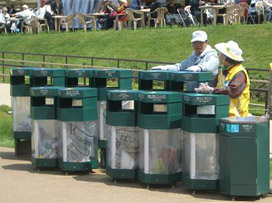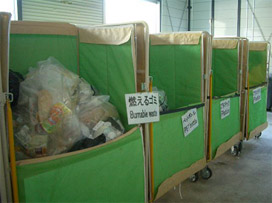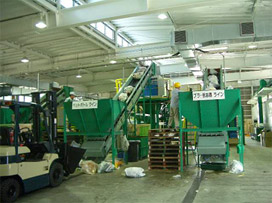Garbage Separation: 9 Categories for Visitors, 17 for Participants (Over 80 Collection Stations at Both EXPO Sites)
One of the subthemes of the EXPO 2005 Aichi, Japan is “Development for Eco-Communities,” and active efforts are being made to promote the 3Rs (reduce, reuse, and recycle). With regard to waste, for example, garbage discharged by visitors and garbage discharged by participants are both subject to separate disposal in several categories. The target is to recycle as resources about 85% of the garbage produced at the EXPO sites.
There are 9 categories of separate disposal for garbage discharged by visitors: (1) PET bottles; (2) paper cups and paper containers; (3) plastics; (4) disposable wooden chopsticks; (5) paper items; (6) raw waste; (7) burnable garbage; (8) nonburnable garbage; and (9) leftover drinking water.
In addition, the 17 categories for participants also include aluminum cans, steel cans, bottles, cardboard boxes, and waste cooking oil.
Visitors can discharge separate waste at Garbage Disposal Stations set up at more than 80 places on the sites. From there the garbage is taken to intermediate garbage collection sites called Substockyards, set up at 16 places, from where it is taken, together with garbage discharged in 17 categories by participants, to the final disposal site, called the Main Stockyard. At the Main Stockyard, such work as volume reduction and blocking (melting and solidifying) of cans and PET bottles and removal of cardboard box packing is carried out so that the waste can be transferred to a disposal facility outside the EXPO sites.

Garbage Disposal Station

Substockyard

Main Stockyard
There are three objectives behind this implementation of garbage separation in so many categories:
- The detailed separation of garbage at the time of disposal makes it even more possible to promote the 3Rs aimed at realizing the development of an eco-community.
- Through the detailed separation of garbage, both visitors and participants are made even more aware than usual of the fact that if garbage is mixed, it is waste, but if it is separated, it is a resource. Garbage separation provides an opportunity to further deepen understanding of waste recycling.
- Overseas visitors and the staff of foreign pavilions can gain an understanding of the present situation and future image of garbage disposal in Japan.
The recycling of separated garbage is the most easy-to-understand model for the promotion of an eco-community and is an activity that can be participated in by all people around the world. Our hope is that the separation of garbage on an unprecedented scale of 9 – 17 categories might help, even a little, in fostering a consciousness of protecting the Earth's limited resources.


